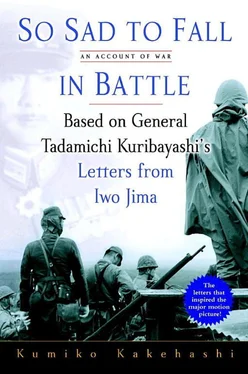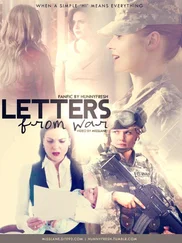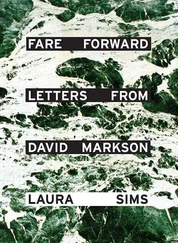Takako fell in love with an assistant director at Daiei and retired after appearing only “once or twice in films where she was listed in ‘The Rest of the Cast’ section of the credits.” She married him after graduating from university and was blessed with three children. She subsequently got a qualification as a nursery school teacher and worked as the head of a nursery that her father-in-law had set up.
“My mother worked very hard to send me to university. My parents-in-law also treated me very kindly, and I’ve lived my life without experiencing any real hardship. I’m sure that my father, who was so worried about my future, is very happy.”
Then she thought for a while and added, “I think that my father was happy, too. He was able to live to over fifty in those difficult times and he rose to a high rank as a military man. Yes… I think he had a happy life. Really.”
Without thinking I blurted out, “Do you mean even right up to the very end?” She nodded, and said “Yes” emphatically.
THERE WAS A REASON behind my asking so tactless a question: I couldn’t help but think that Kuribayashi must have died feeling thwarted and frustrated. The more research I did, the more I realized how Iwo Jima had been abandoned even before the battle was begun.
With the defeat in the Battle of the Philippine Sea and the fall of Saipan, which meant that the “national area to be defended at all costs” had been breached, the Imperial General Headquarters formulated its shôgosakusen —meaning “strategy for victory”—on July 21, 1944:
We shall strengthen our defenses along a new line of defense running through the Philippines, Taiwan, Nansei Shotô, Ogasawara, the Mainland and the Kuril Islands. If the enemy attacks us anywhere in this area, the army and navy will immediately mobilize their forces and crush them.
Such was the new policy. If the new defense line were to be broken, then Japan would be finished. The so-called Victory Strategy was no more than a desperate last stand.
This strategy and the imperial mandate (the official order from the emperor, who was daigensui , or supreme commander) endorsing it were never transmitted to Iwo Jima. And this was despite the fact that Ogasawara was included in the “new defense line” that Imperial General Headquarters had decided to defend to the death. The Imperial General Headquarters had decided that the Philippines was a more pressing problem.
In August, Major General Sanada, chief of the Army General Staff, and Rear Admiral Tasuku Nakazawa, chief of the Naval General Staff, visited Iwo Jima. Four of Kuribayashi’s requests on that occasion were recorded in the diary of Major General Sanada.
1: At present we have only ten fighter planes (including one heavy fighter), and three mid-size attack planes. When I left Tokyo, I was informed we would be provided with 48 fighters and 48 mid-size attack planes. With current numbers, we are unable to conduct patrols.
4: We are using only 12 to 13 twin machine guns. In total there are more than 160 25-mm twin machine guns available. The (infantry) battalions only have two light machine guns per platoon.
There were more than twenty thousand men on the island, but a paltry total of only thirteen fighters and mid-size attack planes. Kuribayashi is also complaining that when it comes to weapons, each platoon has only two light machine guns. The ships that transported supplies to Iwo Jima at this time were often loaded with large quantities of green bamboo. If a ship was attacked and went down, the sailors could cling to it and swim; while, if the ship got through, soldiers could fashion the bamboo into spears to use in lieu of small arms on the battlefield.
Airplanes and weapons were not the only things in short supply.
5: I want thirty-five SB boats [1,000-ton second-class transport vessels] between here and Chichi Jima. I urgently want fishing boats and motorized sailing ships to be mobilized to make the trip between Chichi Jima and Iwo Jima.
[In Chichi Jima] there are enough provisions for a year and a half, but we only have enough for fifty days here. It is unacceptable for ships to transport things as far as Chichi Jima, and then just go back home. I want heavy and light machine guns to be airfreighted here. I was promised that 250 light machine guns and 160 heavy machine guns would be sent, but only one quarter of that number reached Chichi Jima. I also urgently need light trench mortars.
9: Since the start of June, we have had neither alcohol nor anything sweet. The navy have their PX [a shop where you can buy everyday goods, food, and drink] and they received an increase in the sake ration. It is not good for the difference in treatment to be so blatant on such a small island.
Clearly there were too few supply ships going between Chichi Jima and Iwo Jima, and the necessary provisions and weapons were just not making it out to Iwo Jima. There is something pitiful about the commander in chief having to beg for things to be sent to him even in fishing boats if need be. Similarly, “motorized sailing ships” were simply sailing vessels with a motor attached. Used for transporting freight along the coast, they hardly deserve to be called supply ships, particularly in wartime.
In this situation, Kuribayashi was desperately trying to figure out how to defend the island from an enemy who could attack at any time. In the end, only one quarter of the necessary materials that had been promised for the underground defenses actually arrived, while weapons and ammunition continued to remain in short supply.
Nonetheless, at this time the Imperial General Headquarters still appeared to take Iwo Jima seriously, regarding it as “a place requiring priority reinforcement as part of homeland defense.” The strategy was to use concentrated air-power to annihilate the Americans when they attacked.
Things were in short supply on every front. The Imperial General Headquarters, which had overextended its battle lines, was busily devising plans and issuing orders, but was simply unable to dispatch the necessary materials to actually implement any of those plans. It was more than just a matter of a lack of supplies. Since Japan had lost naval supremacy, many of its supply ships were being sunk, so few made it through to their destinations.
As the tide of the war in the Pacific started to turn against the Japanese, the interest of the Imperial General Headquarters switched to the final battle on the homeland, and the defense of Iwo Jima was neglected.
The “Basic Principles of the Imperial Army and Imperial Navy Operations Plan,” the first strategic plan of the war devised by the army and navy together, was drawn up on January 20, 1945. At this stage, Iwo Jima was still defined as “an important territory that must be safeguarded as the frontline of homeland defense.”
That position changed on February 6 when, following on the heels of the “Basic Principles,” the “Research into an Agreement on Army-Navy Cooperation on Air Strategy (Provisional Title)” was decided. This document declared that “Ultimately, Iwo Jima will inevitably fall into the hands of the enemy.” This was the point when it was decided to abandon the place before the fighting had even started.
The reasons the Imperial General Headquarters gave were that since Iwo Jima was located “far away from the air-force bases on the Japanese homeland, exercising air power there is problematic;” and that “it has little value for the Americans as a base from which to invade the Japanese homeland.” If they really believed that, why, one wonders, did they send twenty thousand men to the island? Their policies were so inconsistent that they seem to have been made up haphazardly as they went along.
In the end, the garrison on Iwo Jima met with defeat after holding out for thirty-six days. Few Japanese people know how heroically Kuribayashi and his men fought. The hell that they endured is now buried in history.
Читать дальше












